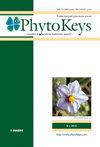A new combination and synonym in Bupleurum (Apiaceae, Apioideae), based on morphological, molecular and cytological evidence
IF 1.3
3区 生物学
Q3 PLANT SCIENCES
引用次数: 0
Abstract
Specimen examinations and field observations revealed that Bupleurum smithii var. parvifolium was distinctly different from B. smithii var. smithii in umbel, leaf, and fruit morphology, but was very similar to B. commelynoideum var. flaviflorum. Based on these morphological evidences, the present study re-examined the taxonomic status of these taxa through morphological, cytological, and phylogenetic analyses. The results showed distinguishable features in the width of middle leaves and bracteoles of B. smithii var. parvifolium compared to B. smithii var. smithii. Morphological variation between B. smithii var. parvifolium and B. commelynoideum var. flaviflorum was continuous and overlapping. Notably, the chromosome number of B. smithii var. parvifolium was 2n = 14 (x = 7), consistent with B. commelynoideum var. flaviflorum, whereas B. smithii var. smithii was 2n = 64 (x = 8). Additionally, phylogenetic analyses revealed B. commelynoideum var. flaviflorum nested within B. smithii var. parvifolium, and that both were distant from the B. smithii var. smithii and B. commelynoideum var. commelynoideum. Based on the evidence above, the differences between B. smithii var. parvifolium and B. smithii var. smithii extend beyond the level of intraspecific variation, and B. commelynoideum var. flaviflorum is considered to be identical with B. smithii var. parvifolium. Hence. A new combination and status, B. parvifolium (Shan & Y.Li) Q.R.Liu & L.H.Wang, comb. et stat. nov., is proposed. Furthermore, B. commelynoideum var. flaviflorum should be treated as a synonym of B. parvifolium.基于形态学、分子学和细胞学证据的 Bupleurum(Apiaceae,Apioideae)的新组合和异名
smithii var. smithii 在伞形花序、叶片和果实形态上明显不同,但与 B. commelynoideum var.基于这些形态学证据,本研究通过形态学、细胞学和系统发育分析重新审视了这些分类群的分类地位。结果表明,与 B. smithii var.smithii var. parvifolium 与 B. commelynoideum var.值得注意的是,B. smithii var. parvifolium 的染色体数为 2n = 14(x = 7),与 B. commelynoideum var.此外,系统发生分析表明,B. commelynoideum var.基于上述证据,B. smithii var.因此。parvifolium (Shan & Y.Li) Q.R.Liu & L.H.Wang, comb. et stat. nov.此外,B. commelynoideum var.
本文章由计算机程序翻译,如有差异,请以英文原文为准。
求助全文
约1分钟内获得全文
求助全文
来源期刊

PhytoKeys
PLANT SCIENCES-
CiteScore
2.60
自引率
14.30%
发文量
189
审稿时长
6 weeks
期刊介绍:
PhytoKeys is a peer-reviewed, open-access, online and print, rapidly produced journal launched to support free exchange of ideas and information in systematic botany.
All papers published in PhytoKeys can be freely copied, downloaded, printed and distributed at no charge for the reader. Authors are thus encouraged to post the pdf files of published papers on their homepages or elsewhere to expedite distribution. There is no charge for color.
 求助内容:
求助内容: 应助结果提醒方式:
应助结果提醒方式:


